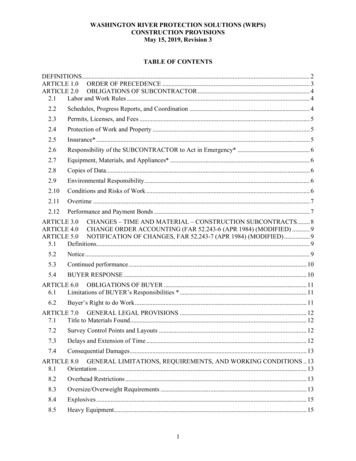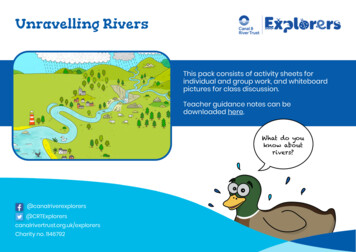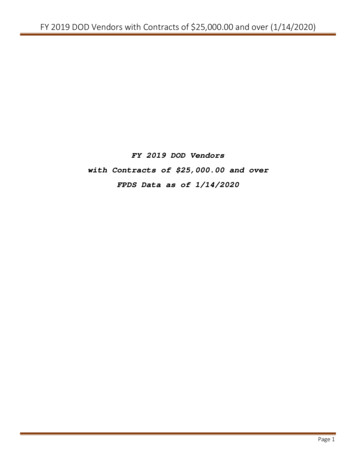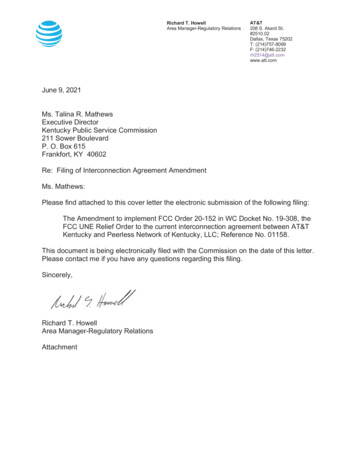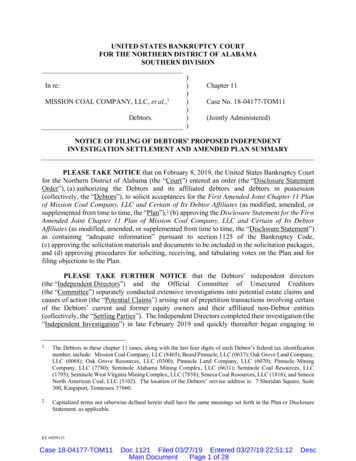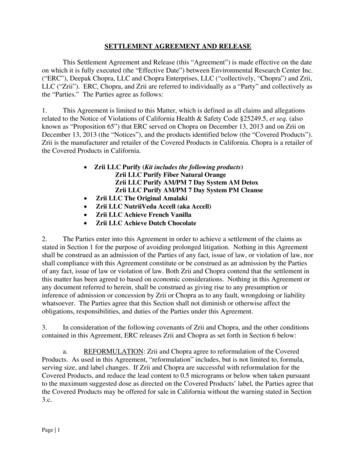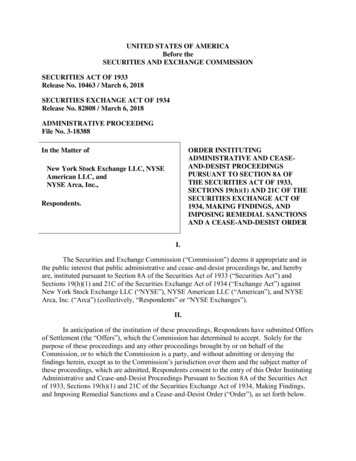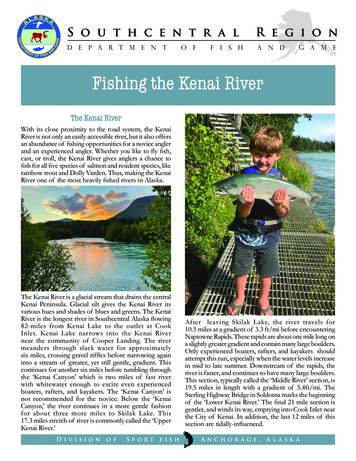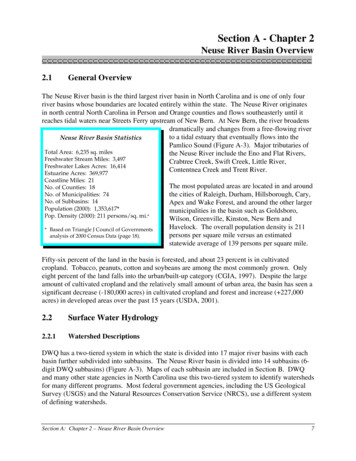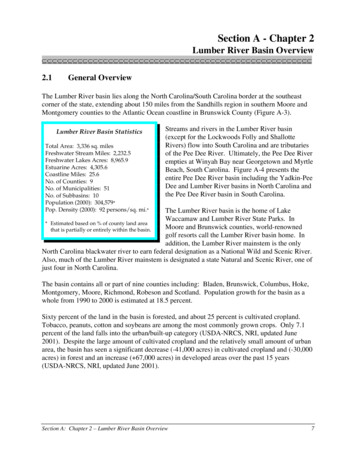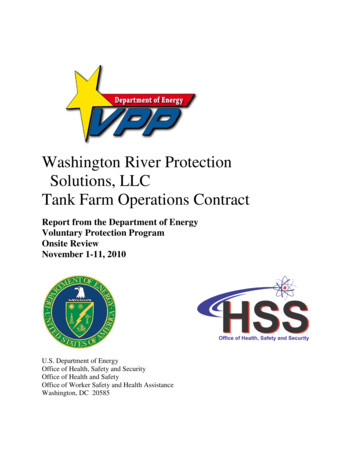
Transcription
Washington River ProtectionSolutions, LLCTank Farm Operations ContractReport from the Department of EnergyVoluntary Protection ProgramOnsite ReviewNovember 1-11, 2010U.S. Department of EnergyOffice of Health, Safety and SecurityOffice of Health and SafetyOffice of Worker Safety and Health AssistanceWashington, DC 20585
Washington River Protection Solutions, LLCDOE-VPP Onsite ReviewNovember 2010ForewordThe Department of Energy (DOE) recognizes that true excellence can be encouraged and guidedbut not standardized. For this reason, on January 26, 1994, the Department initiated the DOEVoluntary Protection Program (VPP) to encourage and recognize excellence in occupationalsafety and health protection. This program closely parallels the Occupational Safety and HealthAdministration (OSHA) VPP. Since its creation by OSHA in 1982, and DOE in 1994, VPP hasdemonstrated that cooperative action among Government, industry, and labor can achieveexcellence in worker safety and health. The Office of Health, Safety and Security (HSS)assumed responsibility for DOE-VPP in October 2006. HSS is expanding complex-widecontractor participation and coordinating DOE-VPP efforts with other Department functions andinitiatives, such as Enforcement, Oversight, and the Integrated Safety Management System.DOE-VPP outlines areas where DOE contractors and subcontractors can surpass compliancewith DOE orders and OSHA standards. The program encourages a “stretch for excellence”through systematic approaches, which emphasize creative solutions through cooperative effortsby managers, employees, and DOE.Requirements for DOE-VPP participation are based on comprehensive management systemswith employees actively involved in assessing, preventing, and controlling the potential healthand safety hazards at their sites. DOE-VPP is designed to apply to all contractors in the DOEcomplex and encompasses production facilities, laboratories, and various subcontractors andsupport organizations.DOE contractors are not required to apply for participation in DOE-VPP. In keeping withOSHA and DOE-VPP philosophy, participation is strictly voluntary. Additionally, anyparticipant may withdraw from the program at any time. DOE-VPP consists of three programswith names and functions similar to those in OSHA’s VPP: Star, Merit, and Demonstration.The Star program is the core of DOE-VPP. This program is aimed at truly outstandingprotectors of employee safety and health. The Merit program is a steppingstone for participantsthat have good safety and health programs, but need time and DOE guidance to achieve true Starstatus. The Demonstration program, expected to be used rarely, allows DOE to recognizeachievements in unusual situations about which DOE needs to learn more before determiningapproval requirements for the Merit or Star program.By approving an applicant for participation in DOE-VPP, DOE recognizes that the applicantexceeds the basic elements of ongoing, systematic protection of employees at the site. Thesymbols of this recognition provided by DOE are certificates of approval and the right to useflags showing the program in which the site is participating. The participant may also choose touse the DOE-VPP logo on letterhead or on award items for employee incentive programs.This report summarizes the results from the evaluation of Washington River ProtectionSolution, LLC (WRPS), the Hanford Tank Farm Operations Contractor, during the period ofNovember 1-11, 2010, and provides the Chief Health, Safety and Security Officer with thenecessary information to make the final decision regarding WRPS participation in DOE-VPP.i
Washington River Protection Solutions, LLCDOE-VPP Onsite Review, November 2010TABLE OF CONTENTSEXECUTIVE SUMMARY . ivOPPORTUNITIES FOR IMPROVEMENT. viI.INTRODUCTION . 1II.INJURY INCIDENCE/LOST WORKDAYS CASE RATE . 3III. MANAGEMENT LEADERSHIP . 41V. EMPLOYEE INVOLVEMENT . 11V.WORKSITE ANALYSIS . 15VI. HAZARD PREVENTION AND CONTROL. 19VII. SAFETY AND HEALTH TRAINING . 25VIII. CONCLUSIONS . 30Appendix A . 1ii
Washington River Protection Solutions, LLCDOE-VPP Onsite Review, November 2010ABBREVIATIONS AND TRCVPPWRPSWTPAs Low As Reasonably AchievableAdvanced Med HanfordBureau of Labor StatisticsBuyer’s Technical RepresentativeComputer-Based TrainingCode of Federal RegulationsChemical Hazard Awareness TrainingChemical Vapor Solutions TeamDays Away, Restricted, or TransferredDefense Nuclear Facilities Safety BoardDepartment of EnergyDocumented Safety AnalysisEmployee Accident Prevention CouncilEmployee Job Task AnalysisEnvironment, Safety, Health and QualityFacility Emergency Hazard Information ChecklistFiscal YearGeneral Hazard AnalysisHanford Atomic Metal Trades CouncilHanford General Employee TrainingHuman Performance ImprovementOffice of Health, Safety and SecurityIndustrial HygieneIntegrated Safety ManagementIntegrated Safety Management SystemIntegrated Training Electronic MatrixJob Hazard AnalysisMobile Arm Retrieval SystemMaterial Safety Data SheetNorth American Industry Classification SystemOn-the-Job-TrainingOffice of River ProtectionOccupational Safety and Health AdministrationProblem Evaluation ReportPreventive MaintenancePerformance Objectives, Measures, and CommitmentsPersonal Protective EquipmentSafe Work EnvironmentHSS DOE-VPP TeamTank Operation ContractTotal Recordable CasesVoluntary Protection ProgramWashington River Protection Solutions, LLCWaste Treatment Plantiii
Washington River Protection Solutions, LLCDOE-VPP Onsite Review, November 2010EXECUTIVE SUMMARYIn July 2008, the Department of Energy (DOE) Office of River Protection awarded the TankOperation Contract to Washington River Protection Solutions, LLC (WRPS), replacing theformer tank operations contractor. The operational phase of the WRPS contract went into effecton October 1, 2008. Two organizations under the former contractor were DOE VoluntaryProtection Program (VPP) Star participants. Under the contract transition process, WRPScommitted to maintaining that Star status, and believed that changes to the program would not beso extensive as to require withdrawal from the program. As such, WRPS was placed in atransitional status until such time as an onsite evaluation by the Office of Health, Safety andSecurity (HSS) could be performed. This report documents the result of that evaluation.Throughout the transition process, WRPS has maintained very low accident and injury rates thatare 80 percent better than its comparison industry. The HSS DOE-VPP Team’s (Team) reviewof accident and injury logs, as well as interviews with workers, did not reveal any concerns withunderreporting or improper classification of worker injuries. Further, most accidents and injuriesare occurring from low hazard activities as a result of slips, trips, and hand/finger injuries, not asa result of the higher hazard work associated with management and cleanup of the tank farms.There is no doubt that WRPS managers are firmly committed to establishing a safe and healthywork environment. WRPS has not yet effectively translated that commitment into a mature,effective working partnership with the workforce. Many changes made in the previous 2 yearshave been made without ensuring worker input and concerns are adequately addressed, and theworkforce has not effectively committed to those changes. WRPS managers are struggling insome cases to overcome many years of workers’ previous history at the tank farms. Efforts toachieve more efficient performance and increase accountability have, in some cases, beenstymied by workers who feel disenfranchised and mistreated over the years. Some project areasare functioning much better and should be considered as a model for other areas that arestruggling to implement an excellence model in safety and health. Recognizing the need forchange, WRPS managers have increased their field presence, but they must be much moreproactive in reaching out to the workforce to gain its trust and acceptance in order to achieveDOE-VPP Star status.WRPS has retained the primary means of encouraging employee involvement through thetransition process. Most Employee Accident Prevention Councils (EAPC) are functioning veryeffectively to encourage worker ideas and resolve worker issues. EAPCs, representing the bulkof the bargaining unit workers, have seen a reduction in employee participation. In those cases,managers and workers have not yet consistently worked together to share positive lessonslearned and experiences between EAPCs. Bargaining unit employees’ attendance at EAPCmeetings has dropped, and some workers and managers have not developed sufficient mutualtrust and respect to form teaming relationships. Overall, direction and guidance to EAPCs hasnot been effective in developing a consistent teaming approach. Additional recognition andencouragement of workers to raise concerns and proactively assist managers in developingcampaigns and initiatives will help raise safety awareness and reverse negative trends. Bothmanagers and workers must develop a path forward to communicate and implement a proactiveteaming approach to safety that allows and encourages employees to take ownership of the safetyprogram to move to the Star level.iv
Washington River Protection Solutions, LLCDOE-VPP Onsite Review, November 2010WRPS and the previous tank farm operating contractor established an effective technical basisthat captures the analysis of the tank farm vapors, one of the primary safety concerns at the tankfarms. The Chemical Vapor Solutions Team and industrial hygienists continue to work togetherto analyze the hazards and risks. WRPS is also working closely with the Waste Treatment Plant(WTP) construction project to ensure actions taken in the tank farms will not adversely affecteventual operation of WTP. Throughout the transition process, WRPS has had multipleassessments of Integrated Safety Management (ISM) that verified the essential elements of ISMare in place, but identified that there are some continuing issues in work planning and controland hazard analysis. WRPS needs to continue working to improve those issues and allowimprovements to mature and stabilize before they are evaluated for effectiveness. The worksiteanalysis tenet of VPP cannot be considered met until those changes have had sufficient time tomature.Overall, WRPS has an effective hazard prevention and control program. WRPS has proactivelypursued new technologies and methods that reduce potential worker exposures to hazardous tankvapors. WRPS has identified some weaknesses in work planning, scheduling, and preventivemaintenance and is in the process of addressing these weaknesses. WRPS managers shouldfurther engage the workers in a collaborative process that will effectively address theseweaknesses.WRPS safety and health training and the associated training and qualification programs are wellestablished and ensure that employees are appropriately trained to recognize the hazards toprotect themselves and their coworkers. WRPS training programs equip managers, supervisors,and employees with the knowledge to understand the established health policies, rules, andprocedures in order to promote safe work practices and minimize exposure to hazards.Throughout this report, the Team has identified opportunities for improvement. Theseopportunities indicate areas the Team believes are critical for WRPS to achieve DOE-VPP Starstatus. The Team recognizes that WRPS has made significant progress toward achieving Starstatus for the company as a whole. Changes to the program scope and structure under the newcontract have been more extensive than originally anticipated. As such, the Team recommendsthat WRPS be moved from the transitional status and be admitted to DOE-VPP as a newapplicant at the Merit level. As a Merit participant, WRPS will address the identifiedopportunities for improvement with the committed assistance from HSS. In addition, HSS willperform annual progress assessments until WRPS achieves Star status.v
Washington River Protection Solutions, LLCDOE-VPP Onsite Review, November 2010TABLE 1OPPORTUNITIES FOR IMPROVEMENTOpportunity for ImprovementPageWRPS should revise the performance incentives program to clearly identify toworkers the actions they should perform in order to earn periodic performanceincentives.4WRPS needs to resolve issues identified in the past external and internalreviews of its ISMS, stabilize the work planning and control processes andprocedures, and ensure workers fully understand, agree with, and implementthose processes and procedures.7WRPS managers, supervisors, and workers all need to commit to eliminatingany appearance of a hostile work environment, and ensure those that will notmake such a commitment are held accountable.7WRPS should work toward fully integrating goals between the POMC and theEAPCs and find ways to link employee awards and incentives to actions thathelp meet those goals.8WRPS should identify and implement specific team building activities andtraining for the Area Teams in Base Operations.8WRPS managers should significantly increase their presence in the workspacesbeyond the one observation per month in order to establish effective workingrelationships with the workers.8WRPS should indentify and implement training for managers on effectivechange management strategies and ensure worker input for future changes isactively sought and used.8WRPS should consider reinstituting Employee Response Teams to helpidentify, communicate, and resolve workers’ concerns related to the changesbeing made.9WRPS needs to implement an effective, performance-based element to itsannual VPP self-assessment and ensure the assessment is sufficiently selfcritical and performance-based to identify improvement opportunities andestablish specific safety improvement goals.WRPS should implement a process to provide for cross-organizationalobservation and mentoring for workers, supervisors, and managers as a meansof breaking down organizational barriers, sharing lessons learned andexperiences, and encouraging more consistent implementation of safetyprocesses and procedures.WRPS should work with HAMTC, ORP, DOE-Richland, and other sitecontractors to ensure that workers not only have the right and ability to stopwork, but also a means to pursue a less restrictive process for questions orvi9910
Washington River Protection Solutions, LLCDOE-VPP Onsite Review, November 2010concerns that can be easily and quickly addressed.WRPS should continue efforts to revitalize the Peer Safety ObservationProgram as a means of encouraging and expanding worker involvementdemonstrating managers’ support for safety improvements.11WRPS should consider expanding the use of work teams involving bothworkers and managers to develop, rollout, and train workers on new processesor proposed organizational changes.12WRPS needs to identify and implement an effective working model tocommunicate best practices, successes, and failures between EAPCs.12WRPS should consider implementing a lower-level system, such as a workerconcern logbook, that workers use and manage to identify worker concerns,document ideas for resolution, and review daily.13WRPS should revise the JHA process to capture the model described in OSHApublication 3071 2002 (revised), document the analysis and rationale forcontrol selection, and provide additional hazard analysis training for personnelon that process to ensure consistent and thorough application.18WRPS should consider reviewing existing databases and information systemsin use at the site for correlations and use as additional leading indicators andensure leading indicators are appropriately published and communicated to theworkforce.18WRPS should look to CVST as a model to emulate and attempt to recreate thatworker involvement and trust in current areas of concern; i.e., the work controlprocess.20WRPS should find additional means to communicate sample results to workers,provide workers additional training to better understand the technical basis forthe IH sampling program, and help workers develop confidence in the safetyand health staff.20WRPS managers need to demonstrate a highly visible commitment toperforming work correctly despite any schedule pressures and ensure they donot create opportunities for workers to raise concerns regarding managersrelated to procedure compliance or safety.21WRPS needs to complete the maintenance program reevaluation as quickly aspossible and establish a plan to reduce remaining backlog to a manageablelevel.22WRPS should ensure decisions to remove equipment from current PM scheduleare documented and analyzed, and communicate that analysis to the workers.22WRPS needs to develop a program to identify equipment that is no longer inthe inspection and calibration program by labeling them “DO NOT USE” or22vii
Washington River Protection Solutions, LLCDOE-VPP Onsite Review, November 2010convert back to a labeled inspection program that identifies properlymaintained equipment.WRPS needs to accelerate implementation of the 8-week rolling schedule as ameans of removing barriers to safe and efficient work completion.22WRPS needs to ensure methods of communicating safety-emphasis messagesto workers are effective in making workers aware of those trends.23WRPS should consider utilizing experienced, restricted-duty tank farm workersto mentor newly hired work planners in the development of work packagesduring their restricted duty.24WRPS needs to revise the PER training materials and methods to ensureworkers understand how to access the PER system and its purpose and ensurethey are proficient in its use.28viii
Washington River Protection Solutions, LLCI.DOE-VPP Onsite Review, November 2010INTRODUCTIONThe Hanford Site tank farms contain approximately 57 million gallons of radioactive and mixedwaste stored in 177 large, aging, underground tanks. This nuclear waste is the result of morethan four decades of reactor operations and plutonium production for National defense. Thesystems and infrastructure that support storage of the waste are aging and pose a threat to theenvironment. The solution to this problem is to safely and cost effectively retrieve, process, andimmobilize this waste and to execute the compliant closure of the tank farm system so that it nolonger poses a threat to the environment.The Department of Energy’s (DOE) Office of River Protection (ORP) manages the cleanup ofthe Hanford Site tank waste. In July 2008, DOE-ORP awarded the Tank Operation Contract(TOC) to Washington River Protection Solutions (WRPS), replacing the former tank operationscontractor. The operational phase of the WRPS contract went into effect on October 1, 2008.The scope of the tank operations contract includes: Base Operations of the tanks, AnalyticalLaboratory Support, Single-Shell Tank Retrieval and Closure, Waste Treatment Plant Support,and Supplemental Treatment.The previous tank farm contractor had achieved DOE-Voluntary Protection Program (VPP) Starstatus for two of its projects now under TOC. Those projects were Analytical Technical Servicesresponsible for facility operation and support of the 222-S Laboratory, and Waste FeedOperations now under Base Operations. As a result of the new contract, WRPS has developedand submitted a new application representing all the WRPS projects under one application forentrance into DOE-VPP.WRPS utilized the 2009 annual self-assessment to assess employee opinions of unifying the twoStar projects into one. The review demonstrated employee and union leadership approval withthat action. WRPS conducted and successfully completed an Integrated Safety ManagementSystem (ISMS) review in 2009 as well.WRPS now consists of three operational line organizations: (1) Base Operations, including the222-S Laboratory; (2) the Single-Shell Tank Retrieval and Closure project; and (3) Tank FarmProjects. These organizations are responsible for safe and environmentally compliant operation,maintenance, radiological control, project management, construction, work management, andindustrial hygiene for 149 single-shell tanks, 28 double-shell tanks, and the 242-A Evaporator inthe Hanford Site’s 200 Area and associated facilities. A fourth line organization providessupport to the Waste Treatment Plant (WTP). Several functional organizations then provideengineering, safety, quality, project management, human resources, and other common corporatesupport services to each of these organizations. Under TOC, WRPS has significantly expandedthe scope of its VPP application, increasing from 700 to approximately 1,600 employees. WRPSbargaining unit workers are represented by the Hanford Atomic Metal Trades Council(HAMTC). HAMTC fully supports the DOE-VPP process.WRPS workers contend with numerous environmental, industrial, and construction hazards, aswell as radiological and chemical hazards (including exposure to potentially hazardous chemicalvapors emanating from the tank waste and beryllium exposure). Industrial hazards includeelectrical, mechanical, scaffold work, and working with overhead loads. Also, potential nuclearsafety hazards receive due consideration during tank-to-tank waste transfer activities.1
Washington River Protection Solutions, LLCDOE-VPP Onsite Review, November 2010In December 2008, WRPS notified the Office of Health, Safety and Security (HSS) of itscommitment to continue participation in DOE-VPP. They further communicated that theybelieved the changes under the new contract would not significantly affect the existingorganizations that had already achieved Star status and requested to retain recognition under thetransitional process outlined in an August 2008 memo from the Chief Health, Safety andSecurity Officer. Under that process, WRPS was required to: (1) establish new writtencommitments by both management and labor consistent with the five tenets of VPP; (2) identifyaspects of the existing VPP that would be evaluated for change; (3) develop a formal action planto transition from the current to the revised (new contract) VPP; and (4) submit a revisedapplication in a timeframe that enabled scheduling of an onsite evaluation by the HSS DOE-VPPTeam (Team) within 24 months of the contract transition. HSS received the application andscheduled the onsite review for November 1-12, 2010. This report documents the results of thatonsite review.2
Washington River Protection Solutions, LLCII.DOE-VPP Onsite Review, November 2010INJURY INCIDENCE/LOST WORKDAYS CASE RATEInjury Incidence/Lost Workdays Case Rate (WRPS )CalendarHoursTotalTRCDART* DART*YearWorkedRecordable 6450.363-YearTotal7,524,817391.04180.48Bureau of Labor Statistics (BLS-2009)average for NAICS** # 562 Wastemanagement and remediation services5.23.3Injury Incidence/Lost Workdays Case Rate (WRPS Subcontractors)CalendarHoursTRCTRCDART* u of Labor Statistics (BLS-2009)average for NAICS** #562 Wastemanagement and remediation servicesTotal WRPS and Subcontractors(3 Years)01.65001001.6500.6810.685.23.31.020.49* Days Away, Restricted or Transferred** North American Industry Classification SystemTRC Incidence Rate, including subcontractors: 1.02DART Case Rate, including construction and subcontractors: 0.49WRPS accident and injury rates are significantly below the average for their comparisonindustry. These numbers reflect excellent safety and health performance. Review of theaccident and injury logs did not identify any concerns regarding improper case management,incorrect classification, or underreporting of injuries. As of October 2010, the TRC rate forWRPS was 0.8, indicating a small increase in recordable injuries. The Team’s review of the pastseveral years of injuries and illnesses identified a trend in lower hazard slips, trips, hand/fingerincidents, walking working surfaces, etc., at WRPS, which may be the primary cause of thisincrease. WRPS had identified this trend during the summer of 2010 and initiated a focusedsafety campaign on hand, finger, and arm safety that included targeted communications duringsafety and tailgate meetings, as well as ergonomic assessments. Interviews and workobservations by the Team during this assessment indicated most workers did not recall thiscampaign, indicating WRPS may need to find more effective methods to promote safetycampaigns and messages.3
Washington River Protection Solutions, LLCIII.DOE-VPP Onsite Review, November 2010MANAGEMENT LEADERSHIPManagement leadership is a key element of obtaining and sustaining an effective safety culture.The contractor must demonstrate senior-level management commitment to occupational safetyand health, in general, and to meeting the requirements of DOE-VPP. Management systems forcomprehensive planning must address health and safety requirements and initiatives. As withany other management system, authority and responsibility for employee health and safety mustbe integrated with the management system of the organization and must involve employees at alllevels of the organization. Elements of that management system must include: (1) clearlycommunicated policies and goals; (2) clear definition and appropriate assignment ofresponsibility and authority; (3) adequate resources; (4) accountability for both managers andworkers; and (5) managers must be visible, accessible, and credible to employees.WRPS managers are clearly committed to establishing and maintaining a safe work environmentfor all workers. All managers interviewed understood that safe performance of work wasessential to mission success. Three specific work groups: the 222-S Laboratory;the Single-Shell Tank Retrieval and Closure group; and the Tank Farm Projects group, werefunctioning very well as a team. The managers in these groups were clearly present and visibleto their workforces, and the workers were proud of their accomplishments.WRPS has made sufficient resources available for worker safety and health. Resources forsafety (industrial hygiene and industrial safety) are assigned in sufficient numbers to ensureappropriate sampling is performed and appropriate expertise is available when needed. WRPShas also provided ample resources for recognition and promotion of safety improvements,including investments from both DOE and the parent companies. In some cases, workers maynot fully understand their performance incentives and believe that their annual performanceincentive is tied to a specific TRC or DART case rate goal. WRPS has tried to implement aperformance incentive plan that factors in both safety and contract performance, but that has notbeen effectively translated into specific actions that workers can take to achieve the contractperformance and safety objectives. WRPS should revise the performance incentives program toclearly identify to workers those actions they should perform in order to earn periodicperformance incentives.Opportunity for Improvement: WRPS should revise the performance incentives programto clearly identify to workers the actions they should perform in order to earn periodicperformance incentives.WRPS has a formal process for managing subcontractors. That process ensures subcontractscontain appropriate requirements per title10, Code of Federal Regulations (CFR), part 851,DOE Worker Safety and Health Program, and also includes review of the qualifications of eachsubcontractor. Subcontractors are also required to designate a dedicated safety representative forthe contract. Specific requirements, including safety requirements, are documented in the specialconditions section of contracts. These subcontracts contain standard and special provisions,including the appropriate DOE Acquisition Regulations, depending upon the magnitude andcomplexity of the task order.A Buyer’s Technical Representative (BTR) for services or Cognizant Engineer is assigned to actas the day-to-day technical representative by the requisitioning organization, activity, or costaccount manager. The primary duty of BTR or Cognizant Engineer is to provide technical4
Washington River Protection Solutions, LLCDOE-VPP Onsite Review, November 2010direction/clarification to the subcontractor to ensure performance of all elements is in accordancewith the statement of work without placing emphasis on schedule or cost to the detriment ofquality, safety, or the environment. The BTR/Cognizant Engineer is responsible for internalcoordination of, and interface with, the subcontractor regarding the various technicalrequirements, such as quality assurance, safety, health, security, environmental, Price AndersonAmendment Act, and ISMS principles applicable to the performance of the contract pursuant toTOC imp
Overall, WRPS has an effective hazard prevention and control program. WRPS has proactively pursued new technologies and methods that reduce potential worker exposures to hazardous tank vapors. WRPS has identified some weaknesses in work planning, scheduling, and preventive maintenance and is in the process of addressing these weaknesses.
